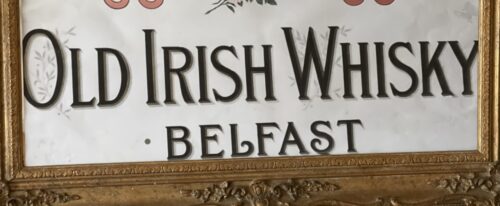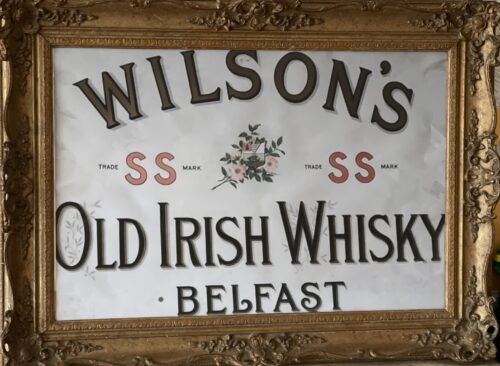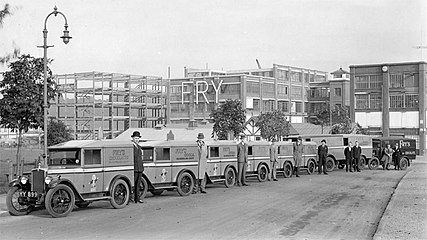-

 Poignant portrait of all time Wexford Hurling Great Nicky Rackard Enniscorthy Co Wexford 35cm x32cm "I was lucky enough to be on a Wexford team that he was involved with," recalled Liam Griffin. "He put his hand on my shoulder and that was like the hand of God touching you. "He was a fantastic man and his presence was just unbelievable. To see him standing there in a dressing-room, you wouldn't be worried about going out on the pitch, you'd just be looking at him." Despite his many years of service to Wexford GAA, Nicky Rackard's life was cut tragically short and at only the age of 53, the legendary hurler passed on after a battle with cancer. As Liam Griffin recalled on OTB AM, Rackard had also had his struggles with alcohol. "He was a gentleman as well, but look, he had his problems when he wasn't a gentleman as well when he had drink taken like most people," he explained. "But look, he was an inspiration too because he went on to do great work for alcoholics and so forth. "But I'm just going to say this, and I'm not saying this to be smart but because I mean it sincerely. After the All-Ireland final when we won it we put the cup in the middle of the floor the next morning after the All-Ireland. "In my view, he'd had such an influence on me and what we were that we stood around the cup and said a few prayers, and I'm not ashamed to say that I can tell you. "I warned them, and I meant it because I had thought about it in the previous weeks and months before, about any of them becoming an alcoholic, like Nicky Rackard. "He was one of the greatest but hero-worship is dangerous and when they walked out that door their lives would change forever. Nicky's life was spoiled by the worship he received and that's an unintended consequence, but it is the truth." The prominent figure upon Wexford's Mt Rushmore in Liam Griffin's opinion, whatever of Nicky Rackard's troubles in life, Griffin believes his legacy as a hurler is unsurpassed. "He led Wexford when we hadn't fields of barley let me tell you, we had pretty barren fields," he recalled. "Nicky Rackard carried on through a lot of thick and thin with Wexford, through a lot of heartache but he eventually put his flag on the top of the mountain. "He's #1 in Wexford, that's for sure."
Poignant portrait of all time Wexford Hurling Great Nicky Rackard Enniscorthy Co Wexford 35cm x32cm "I was lucky enough to be on a Wexford team that he was involved with," recalled Liam Griffin. "He put his hand on my shoulder and that was like the hand of God touching you. "He was a fantastic man and his presence was just unbelievable. To see him standing there in a dressing-room, you wouldn't be worried about going out on the pitch, you'd just be looking at him." Despite his many years of service to Wexford GAA, Nicky Rackard's life was cut tragically short and at only the age of 53, the legendary hurler passed on after a battle with cancer. As Liam Griffin recalled on OTB AM, Rackard had also had his struggles with alcohol. "He was a gentleman as well, but look, he had his problems when he wasn't a gentleman as well when he had drink taken like most people," he explained. "But look, he was an inspiration too because he went on to do great work for alcoholics and so forth. "But I'm just going to say this, and I'm not saying this to be smart but because I mean it sincerely. After the All-Ireland final when we won it we put the cup in the middle of the floor the next morning after the All-Ireland. "In my view, he'd had such an influence on me and what we were that we stood around the cup and said a few prayers, and I'm not ashamed to say that I can tell you. "I warned them, and I meant it because I had thought about it in the previous weeks and months before, about any of them becoming an alcoholic, like Nicky Rackard. "He was one of the greatest but hero-worship is dangerous and when they walked out that door their lives would change forever. Nicky's life was spoiled by the worship he received and that's an unintended consequence, but it is the truth." The prominent figure upon Wexford's Mt Rushmore in Liam Griffin's opinion, whatever of Nicky Rackard's troubles in life, Griffin believes his legacy as a hurler is unsurpassed. "He led Wexford when we hadn't fields of barley let me tell you, we had pretty barren fields," he recalled. "Nicky Rackard carried on through a lot of thick and thin with Wexford, through a lot of heartache but he eventually put his flag on the top of the mountain. "He's #1 in Wexford, that's for sure." -
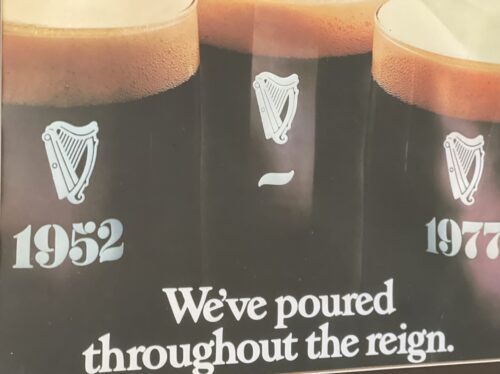
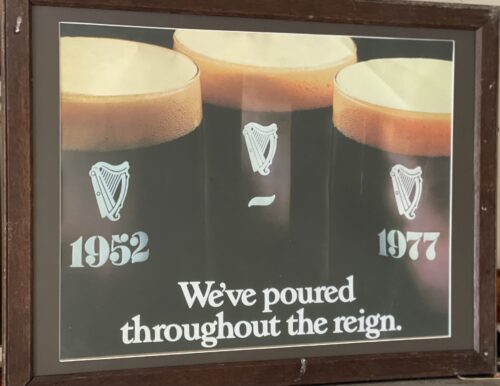 55cm x 70cm Imagination is something Guinness Advertising has never been short of… From John Gilroy’s hapless zookeeper and his menagerie of creatures to a Polynesian surfer and a herd of white horses; from messages in bottles setting sail across the ocean to a single, heart-stoppingly enormous wave. Guinness have been carving out their own creative path for almost a century with decades of extraordinary and enduring print, TV and digital campaigns to their name, and hopefully they will continue to push boundaries to tell stories to the world. Here’s to original thinking !
55cm x 70cm Imagination is something Guinness Advertising has never been short of… From John Gilroy’s hapless zookeeper and his menagerie of creatures to a Polynesian surfer and a herd of white horses; from messages in bottles setting sail across the ocean to a single, heart-stoppingly enormous wave. Guinness have been carving out their own creative path for almost a century with decades of extraordinary and enduring print, TV and digital campaigns to their name, and hopefully they will continue to push boundaries to tell stories to the world. Here’s to original thinking ! -

 40cm x 30cm Enniscrone Co Sligo William Butler Yeats(13 June 1865 – 28 January 1939) Irish poet, dramatist, prose writer and one of the foremost figures of 20th-century literature. A pillar of the Irish literary establishment, he helped to found the Abbey Theatre, and in his later years served two terms as a Senator of the Irish Free State. He was a driving force behind the Irish Literary Revival along with Lady Gregory, Edward Martyn and others. Yeats was born in Sandymount, Ireland, and educated there and in London. He was a Protestant and member of the Anglo-Irish community. He spent childhood holidays in County Sligo and studied poetry from an early age, when he became fascinated by Irish legends and the occult. These topics feature in the first phase of his work, which lasted roughly until the turn of the 20th century. His earliest volume of verse was published in 1889, and its slow-paced and lyrical poems display debts to Edmund Spenser, Percy Bysshe Shelley, and the poets of the Pre-Raphaelite Brotherhood. From 1900, his poetry grew more physical and realistic. He largely renounced the transcendental beliefs of his youth, though he remained preoccupied with physical and spiritual masks, as well as with cyclical theories of life. In 1923, he was awarded the Nobel Prize in Literature.
40cm x 30cm Enniscrone Co Sligo William Butler Yeats(13 June 1865 – 28 January 1939) Irish poet, dramatist, prose writer and one of the foremost figures of 20th-century literature. A pillar of the Irish literary establishment, he helped to found the Abbey Theatre, and in his later years served two terms as a Senator of the Irish Free State. He was a driving force behind the Irish Literary Revival along with Lady Gregory, Edward Martyn and others. Yeats was born in Sandymount, Ireland, and educated there and in London. He was a Protestant and member of the Anglo-Irish community. He spent childhood holidays in County Sligo and studied poetry from an early age, when he became fascinated by Irish legends and the occult. These topics feature in the first phase of his work, which lasted roughly until the turn of the 20th century. His earliest volume of verse was published in 1889, and its slow-paced and lyrical poems display debts to Edmund Spenser, Percy Bysshe Shelley, and the poets of the Pre-Raphaelite Brotherhood. From 1900, his poetry grew more physical and realistic. He largely renounced the transcendental beliefs of his youth, though he remained preoccupied with physical and spiritual masks, as well as with cyclical theories of life. In 1923, he was awarded the Nobel Prize in Literature. -

 35cm x 25cm Limerick William Butler Yeats (13 June 1865 – 28 January 1939) was an Irish poet, dramatist, prose writer and one of the foremost figures of 20th-century literature. A pillar of the Irish literary establishment, he helped to found the Abbey Theatre, and in his later years served two terms as a Senator of the Irish Free State. He was a driving force behind the Irish Literary Revival along with Lady Gregory, Edward Martyn and others. Yeats was born in Sandymount, Ireland, and educated there and in London. He was a Protestant and member of the Anglo-Irish community. He spent childhood holidays in County Sligo and studied poetry from an early age, when he became fascinated by Irish legends and the occult. These topics feature in the first phase of his work, which lasted roughly until the turn of the 20th century. His earliest volume of verse was published in 1889, and its slow-paced and lyrical poems display debts to Edmund Spenser, Percy Bysshe Shelley, and the poets of the Pre-Raphaelite Brotherhood. From 1900, his poetry grew more physical and realistic. He largely renounced the transcendental beliefs of his youth, though he remained preoccupied with physical and spiritual masks, as well as with cyclical theories of life. In 1923, he was awarded the Nobel Prize in Literature.
35cm x 25cm Limerick William Butler Yeats (13 June 1865 – 28 January 1939) was an Irish poet, dramatist, prose writer and one of the foremost figures of 20th-century literature. A pillar of the Irish literary establishment, he helped to found the Abbey Theatre, and in his later years served two terms as a Senator of the Irish Free State. He was a driving force behind the Irish Literary Revival along with Lady Gregory, Edward Martyn and others. Yeats was born in Sandymount, Ireland, and educated there and in London. He was a Protestant and member of the Anglo-Irish community. He spent childhood holidays in County Sligo and studied poetry from an early age, when he became fascinated by Irish legends and the occult. These topics feature in the first phase of his work, which lasted roughly until the turn of the 20th century. His earliest volume of verse was published in 1889, and its slow-paced and lyrical poems display debts to Edmund Spenser, Percy Bysshe Shelley, and the poets of the Pre-Raphaelite Brotherhood. From 1900, his poetry grew more physical and realistic. He largely renounced the transcendental beliefs of his youth, though he remained preoccupied with physical and spiritual masks, as well as with cyclical theories of life. In 1923, he was awarded the Nobel Prize in Literature. -

 Fantastic vintage W.& R.Jacob & Co.Ltd Biscuit & Cake Manufacturers Dublin Advert depicting the famous Dublin Landmark which played such a pivotal role in the 1916 Easter Rising which altered the course of Irish History forever. Clonsilla Dublin 45.5cm x 57.5cm The biscuit making firm of W. & R. Jacob's were one the largest employers in the Dublin of 1916, and their factory was seized on Easter Monday by perhaps 100 members of the 2nd Battalion of the Dublin Brigade of the Irish Volunteers under Thomas MacDonagh. The factory itself was an enormous and formidable Victorian edifice located on the 'block' enclosed by Bishop St, Bride St, Peter's St and Peter's Row, and between St Patrick's Cathedral and St Stephen's Green. Its seizure helped to complete a loop of building cross the south inner city; the factory had two large towers that could act as observation points, while its location was very close to both Camden St and Patrick St: natural routeways for troops entering the city centre from Portobello Barracks in Rathmines and Wellington Barracks on the South Circular Road. There were only a few staff present in the building when the Volunteers broke into it; a number of smaller outposts were established in the area around the factory. While the garrison saw some fighting early in the week, their principal enemies proved to be boredom and the locals: the factory was surrounded by tenements, and the Volunteers were attacked and abused by residents, many of whom were Jacob's workers themselves. The families of servicemen were also quite hostile, but there may have been another reason for this hostility: Michael O'Hanrahan, who was in Jacob's, expressed his concern that the choice of location might endanger local residents if the British chose to attack. As it happens, the factory was largely by-passed, though it was fired upon intermittently throughout the week by troops in Dublin Castle and elsewhere. MacDonagh surrendered in nearby St Patrick's Park on Sunday 30 April; some of the factory was looted after the Volunteers had left. Three members of the Jacob's garrison were executed. Most of the factory was eventually demolished, though fragments of the ground storey and one of the towers are still visible on Bishop St between the DIT campus on Aungier St and the National Archives of Ireland.
Fantastic vintage W.& R.Jacob & Co.Ltd Biscuit & Cake Manufacturers Dublin Advert depicting the famous Dublin Landmark which played such a pivotal role in the 1916 Easter Rising which altered the course of Irish History forever. Clonsilla Dublin 45.5cm x 57.5cm The biscuit making firm of W. & R. Jacob's were one the largest employers in the Dublin of 1916, and their factory was seized on Easter Monday by perhaps 100 members of the 2nd Battalion of the Dublin Brigade of the Irish Volunteers under Thomas MacDonagh. The factory itself was an enormous and formidable Victorian edifice located on the 'block' enclosed by Bishop St, Bride St, Peter's St and Peter's Row, and between St Patrick's Cathedral and St Stephen's Green. Its seizure helped to complete a loop of building cross the south inner city; the factory had two large towers that could act as observation points, while its location was very close to both Camden St and Patrick St: natural routeways for troops entering the city centre from Portobello Barracks in Rathmines and Wellington Barracks on the South Circular Road. There were only a few staff present in the building when the Volunteers broke into it; a number of smaller outposts were established in the area around the factory. While the garrison saw some fighting early in the week, their principal enemies proved to be boredom and the locals: the factory was surrounded by tenements, and the Volunteers were attacked and abused by residents, many of whom were Jacob's workers themselves. The families of servicemen were also quite hostile, but there may have been another reason for this hostility: Michael O'Hanrahan, who was in Jacob's, expressed his concern that the choice of location might endanger local residents if the British chose to attack. As it happens, the factory was largely by-passed, though it was fired upon intermittently throughout the week by troops in Dublin Castle and elsewhere. MacDonagh surrendered in nearby St Patrick's Park on Sunday 30 April; some of the factory was looted after the Volunteers had left. Three members of the Jacob's garrison were executed. Most of the factory was eventually demolished, though fragments of the ground storey and one of the towers are still visible on Bishop St between the DIT campus on Aungier St and the National Archives of Ireland. -

 50cm x 70cm Drumcondra Dublin Once the Willy Wonka chocolate factory of Dublin,Williams & Woods kept generations of children and adults happy with their large range of confectionary items as advertised in this rare, original print from the late 1890s.The company is long gone but happily the building has been put to good use as you can read below.William's & Woods building on King's Inn Street in Dublin City Centre is where it all began - the first home to the Chocolate Factory shared creative space. Once manufacturing various sweet treats including Toblerone and Mint Crisp, this industrial building now houses an eclectic mix of small businesses and individuals in creative sectors including art, design, music, photography, craft, up-cycling, dance, illustration, graphics, events, horticulture, baking and small batch food & drink production. The incredible transformation and re-invention of Dublin's first concrete building into a creative and collaborative space continues in addition to other alternative Chocolate Factory venues around the country.
50cm x 70cm Drumcondra Dublin Once the Willy Wonka chocolate factory of Dublin,Williams & Woods kept generations of children and adults happy with their large range of confectionary items as advertised in this rare, original print from the late 1890s.The company is long gone but happily the building has been put to good use as you can read below.William's & Woods building on King's Inn Street in Dublin City Centre is where it all began - the first home to the Chocolate Factory shared creative space. Once manufacturing various sweet treats including Toblerone and Mint Crisp, this industrial building now houses an eclectic mix of small businesses and individuals in creative sectors including art, design, music, photography, craft, up-cycling, dance, illustration, graphics, events, horticulture, baking and small batch food & drink production. The incredible transformation and re-invention of Dublin's first concrete building into a creative and collaborative space continues in addition to other alternative Chocolate Factory venues around the country.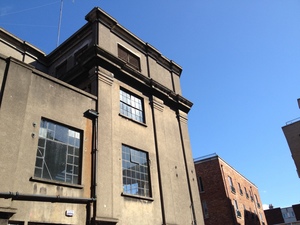
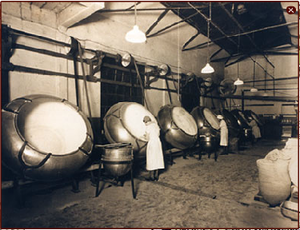
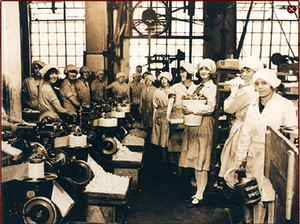
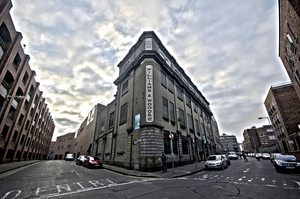 D
D
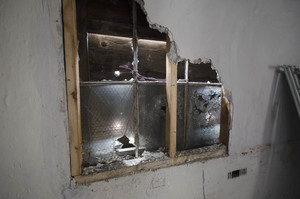
-
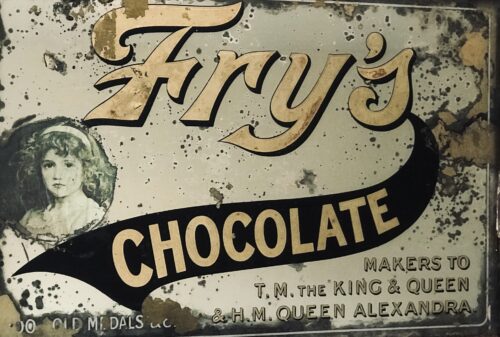
 Fantastic Frys Chocolate Advertising Mirror circa early 1900s. 40cm x 55cm Dublin S. Fry & Sons, Ltd. better known as Fry's, was a British chocolate company owned by Joseph Storrs Fry and his family. Beginning in Bristol in the 18th century, the business went through several changes of name and ownership, becoming J. S. Fry & Sons in 1822. In 1847, Fry's produced the first solid chocolate bar.[1][2] The company also created the first filled chocolate sweet, Cream Sticks, in 1853.[1] Fry is most famous for Fry's Chocolate Cream, the first mass-produced chocolate bar which was launched in 1866, and Fry's Turkish Delight, launched in 1914.[1] Fry, alongside Cadbury and Rowntree's, were the big three British confectionery manufacturers throughout much of the nineteenth and twentieth centuries.[3] The company became a division of Cadbury in the early twentieth century. The division's Somerdale Factory near Bristol was closed after the 2010 takeover of Cadbury's by Kraft Foods.
Fantastic Frys Chocolate Advertising Mirror circa early 1900s. 40cm x 55cm Dublin S. Fry & Sons, Ltd. better known as Fry's, was a British chocolate company owned by Joseph Storrs Fry and his family. Beginning in Bristol in the 18th century, the business went through several changes of name and ownership, becoming J. S. Fry & Sons in 1822. In 1847, Fry's produced the first solid chocolate bar.[1][2] The company also created the first filled chocolate sweet, Cream Sticks, in 1853.[1] Fry is most famous for Fry's Chocolate Cream, the first mass-produced chocolate bar which was launched in 1866, and Fry's Turkish Delight, launched in 1914.[1] Fry, alongside Cadbury and Rowntree's, were the big three British confectionery manufacturers throughout much of the nineteenth and twentieth centuries.[3] The company became a division of Cadbury in the early twentieth century. The division's Somerdale Factory near Bristol was closed after the 2010 takeover of Cadbury's by Kraft Foods.History[edit]
Joseph Fry, a Quaker, was born in 1728. He started making chocolate around 1759. In 1761 Joseph Fry and John Vaughan purchased a small shop from an apothecary, Walter Churchman, and with it the patent for a chocolate refining process.The company was then named Fry, Vaughan & Co.. In 1777 their chocolate works moved from Newgate Street to Union Street, Bristol. Joseph Fry died in 1787 and the company was renamed Anna Fry & Son. In 1795 Joseph Storrs Fryassumed control of the company. He patented a method of grinding cocoa beans using a Watt steam engine. As a result, factory techniques were introduced into the cocoa business. In 1803 Anna Fry died and Joseph Storrs Fry partnered with a Dr. Hunt. The business was renamed Fry & Hunt. In 1822 Hunt retired and Joseph Storrs Fry took on his sons Joseph, Francis and Richard as partners: the firm was renamed J. S. Fry & Sons. The company became the largest commercial producer of chocolate in the UK. In 1835 Joseph Storrs Fry died and his sons took full control. Tom Browne‘s advertisement postcard for Fry's chocolate, 1912In 1847, the Fry's chocolate factory, located in Union Street, Bristol, moulded a chocolate bar suitable for large-scale production.The firm began producing the Fry's Chocolate Cream bar in 1866.Over 220 products were introduced in the following decades, including production of the first chocolate Easter egg in UK in 1873 and the Fry's Turkish Delight (or Fry's Turkish bar) in 1914. In 1896 the firm became a registered private company. It was run by the Fry family, with Joseph Storrs Fry II, grandson of the first Joseph Storrs Fry, as the chairman. In 1881, an employee of Fry's H. J. Packer established his own chocolate business in Bristol. At its eventual home in Greenbank, Bristol, Packer's Chocolate continued to provide local competition for Fry's until 2006, under various owners and brands, from Bonds through to Famous Names and Elizabeth Shaw. Near the start of World War I the company was one of the largest employers in Bristol. Joseph Storrs Fry II died in 1913. By 1919 the company merged with Cadbury's chocolate and the joint company named British Cocoa and Chocolate Company. Under Egbert Cadbury the Fry's division began the move to Somerdale, Keynsham in 1923. After 1981 the name Fry's was no longer in use at Somerdale, but the factory was still a major producer of Cadbury's products. On 3 October 2007, Cadbury announced plans to close the Somerdale plant, the historic home of the Fry's Factory, by 2010 with the loss of some 500 jobs. In an effort to maintain competitiveness in a global marketplace, production was to be moved to a new factory in Poland. Another motivational factor was the high value of the land. Labour MP for Wansdyke, Dan Norris, said, "News of the factory's closure is a hard and heavy blow, not just to the workforce, but to the Keynsham community as a whole". In February 2010, following the takeover of Cadbury plc by Kraft Foods, the closure was controversially confirmed to take place in 2011; Kraft had specifically agreed during the takeover battle to keep the site open. There was widespread outrage in the press and later a House of Commons Select Committee investigation into the affair.Advertisement with the distinctive "five boys" design expressing "Desperation, Pacification, Expectation, Acclamation and Realization "It's Fry's". The reference to Queen Alexandra indicates a date before her death in 1925. Displayed in the Kirkcaldy Museum and Art Gallery
Tom Browne‘s advertisement postcard for Fry's chocolate, 1912In 1847, the Fry's chocolate factory, located in Union Street, Bristol, moulded a chocolate bar suitable for large-scale production.The firm began producing the Fry's Chocolate Cream bar in 1866.Over 220 products were introduced in the following decades, including production of the first chocolate Easter egg in UK in 1873 and the Fry's Turkish Delight (or Fry's Turkish bar) in 1914. In 1896 the firm became a registered private company. It was run by the Fry family, with Joseph Storrs Fry II, grandson of the first Joseph Storrs Fry, as the chairman. In 1881, an employee of Fry's H. J. Packer established his own chocolate business in Bristol. At its eventual home in Greenbank, Bristol, Packer's Chocolate continued to provide local competition for Fry's until 2006, under various owners and brands, from Bonds through to Famous Names and Elizabeth Shaw. Near the start of World War I the company was one of the largest employers in Bristol. Joseph Storrs Fry II died in 1913. By 1919 the company merged with Cadbury's chocolate and the joint company named British Cocoa and Chocolate Company. Under Egbert Cadbury the Fry's division began the move to Somerdale, Keynsham in 1923. After 1981 the name Fry's was no longer in use at Somerdale, but the factory was still a major producer of Cadbury's products. On 3 October 2007, Cadbury announced plans to close the Somerdale plant, the historic home of the Fry's Factory, by 2010 with the loss of some 500 jobs. In an effort to maintain competitiveness in a global marketplace, production was to be moved to a new factory in Poland. Another motivational factor was the high value of the land. Labour MP for Wansdyke, Dan Norris, said, "News of the factory's closure is a hard and heavy blow, not just to the workforce, but to the Keynsham community as a whole". In February 2010, following the takeover of Cadbury plc by Kraft Foods, the closure was controversially confirmed to take place in 2011; Kraft had specifically agreed during the takeover battle to keep the site open. There was widespread outrage in the press and later a House of Commons Select Committee investigation into the affair.Advertisement with the distinctive "five boys" design expressing "Desperation, Pacification, Expectation, Acclamation and Realization "It's Fry's". The reference to Queen Alexandra indicates a date before her death in 1925. Displayed in the Kirkcaldy Museum and Art GalleryArchives
Records relating to both the business and the family are held at Bristol Archives (Ref. 38538). Some records concerning the role of J. S. Fry & Sons within Cadbury are held with the Mondelez International repository at Cadbury's UK headquarters in Bournville.Popular culture
On the BBC television program Being Human, an old Fry's Cocoa billboard hangs prominently on the side of the B&B where the main characters reside in Series 3–5. The billboard is a nod to the show's original Bristol location. In April 2020 an original enamel advertising sign with the distinctive "five boys" trademark design was featured on BBC's Antiques Roadshow and was valued at £1,000-£1,500. The boy featured in the design, Lindsay Poulton, had been photographed in 1886 by his father who, for the first image, soaked a cloth in ammonia and wrapped it round the boy's neck to make him cry. Poulton, in his eighties, related this story to Fry's employees when he was given a tour of the Bristol factory.-
Somerdale Factory soon after opening
See also[edit]
-
-

 Fantastic piece of Tipperary Hurling Nostalgia here as we see a very young Jimmy Doyle being presented with a Thurles Schoolboys Streel League Trophy. 45cm x 35cm. Thurles Co Tipperary "Jimmy Doyle would have seen many things, and watched a lot of hurling, in his 76 years. But the Tipperary legend, who died last Monday, was possibly most pleased to watch the sumptuous performance of his native county, against Limerick, just the day before. Simply put, the way Tipp hurl at the moment is pure Jimmy Doyle - and no finer compliment can be paid in the Premier County. Eamon O'Shea's current group are all about skill, vision, élan, creativity, elegance: the very things which defined Doyle's playing style as he terrorised defences for close on two decades. Indeed, it's a funny irony that the Thurles Sarsfields icon, were he young today, would easily slip into the modern game, such was his impeccable technique, flair and positional sense. There may have been "better" hurlers in history (Cork's Christy Ring surely still stands as the greatest of all). There may even have been better Tipp hurlers - John Doyle, for example, who won more All-Irelands than his namesake. But there was hardly a more naturally gifted man to play in 125 years. The hurling of Doyle's heyday, by contrast with today, was rough, tough, sometimes brutal. His own Tipp team featured a full-back line so feared for taking no prisoners, they were christened (not entirely unaffectionately) "Hell's Kitchen". While not quite unique, Doyle was one of a select group back then who relied less on brute force, and more on quick wrists, "sixth sense" spatial awareness, and uncanny eye-hand co-ordination to overcome. During the 1950s and '60s, when he was in his pomp, forwards were battered, bruised and banjaxed, with little protection from rules or referees. It speaks even more highly, then, of this small, slim man ("no bigger in stature than a jockey", as put by Irish Independent sportswriter Vincent Hogan) that he should achieve such greatness. What, you'd wonder, might have been his limitations - if any - had he played in the modern game? Regardless, his place in hurling's pantheon is assured; one of a handful of players to transcend even greatness and enter some almost supernatural realm of brilliance. This week his former teammate, and fellow Tipp legend, Michael "Babs" Keating recalled how Christy Ring had once told him, "If Jimmy Doyle was as strong as you and I, nobody would ever ask who was the best." Like Ring, Jimmy made both the 1984 hurling Team of the Century, compiled in honour of the GAA's Centenary, and the later Team of the Millennium. We can also throw in a slot on both Tipperary and Munster Teams of the Millennium, and being named Hurler of the Year in 1965 - and that's just the start of one of the most glittering collections of honours in hurling history.
Fantastic piece of Tipperary Hurling Nostalgia here as we see a very young Jimmy Doyle being presented with a Thurles Schoolboys Streel League Trophy. 45cm x 35cm. Thurles Co Tipperary "Jimmy Doyle would have seen many things, and watched a lot of hurling, in his 76 years. But the Tipperary legend, who died last Monday, was possibly most pleased to watch the sumptuous performance of his native county, against Limerick, just the day before. Simply put, the way Tipp hurl at the moment is pure Jimmy Doyle - and no finer compliment can be paid in the Premier County. Eamon O'Shea's current group are all about skill, vision, élan, creativity, elegance: the very things which defined Doyle's playing style as he terrorised defences for close on two decades. Indeed, it's a funny irony that the Thurles Sarsfields icon, were he young today, would easily slip into the modern game, such was his impeccable technique, flair and positional sense. There may have been "better" hurlers in history (Cork's Christy Ring surely still stands as the greatest of all). There may even have been better Tipp hurlers - John Doyle, for example, who won more All-Irelands than his namesake. But there was hardly a more naturally gifted man to play in 125 years. The hurling of Doyle's heyday, by contrast with today, was rough, tough, sometimes brutal. His own Tipp team featured a full-back line so feared for taking no prisoners, they were christened (not entirely unaffectionately) "Hell's Kitchen". While not quite unique, Doyle was one of a select group back then who relied less on brute force, and more on quick wrists, "sixth sense" spatial awareness, and uncanny eye-hand co-ordination to overcome. During the 1950s and '60s, when he was in his pomp, forwards were battered, bruised and banjaxed, with little protection from rules or referees. It speaks even more highly, then, of this small, slim man ("no bigger in stature than a jockey", as put by Irish Independent sportswriter Vincent Hogan) that he should achieve such greatness. What, you'd wonder, might have been his limitations - if any - had he played in the modern game? Regardless, his place in hurling's pantheon is assured; one of a handful of players to transcend even greatness and enter some almost supernatural realm of brilliance. This week his former teammate, and fellow Tipp legend, Michael "Babs" Keating recalled how Christy Ring had once told him, "If Jimmy Doyle was as strong as you and I, nobody would ever ask who was the best." Like Ring, Jimmy made both the 1984 hurling Team of the Century, compiled in honour of the GAA's Centenary, and the later Team of the Millennium. We can also throw in a slot on both Tipperary and Munster Teams of the Millennium, and being named Hurler of the Year in 1965 - and that's just the start of one of the most glittering collections of honours in hurling history. -

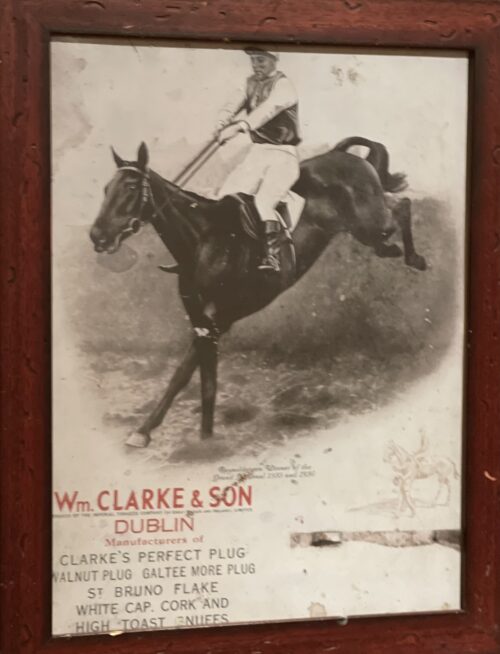 47cm x 35cm During its 180 year history, the Grand National has seen only five horses win consecutive runnings, with this year's victor Tiger Roll joining that exclusive list of dual winners. Until the legendary Red Rum, the last horse to win on his immediate return to Aintree was Reynoldstown, who won the 1935 Grand National in the hands of Mr Frank Furlong - a subaltern in the 9th Lancers - and again the following year ridden by Furlong's great friend and fellow Army officer Mr Fulke Walwyn, later to become a multi-time champion National Hunt trainer. Although two totally different kinds of horses, the long, lean, black Reynoldstown and the diminutive Tiger Roll share a parallel in that both had Flat-bred sires. Reynoldstown was by the good-class My Prince who won among other races the Union Jack Stakes at Aintree but went on to become more famous as an outstanding sire of National Hunt horses including Grand National winners Gregalach (1929) and Royal Mail (1937), while Tiger Roll's father Authorized won the 2007 Epsom Derby under Frankie Dettori. Reynoldstown's dam Fromage was the product of a modest mating to the nearest sire who was within walking distance.
47cm x 35cm During its 180 year history, the Grand National has seen only five horses win consecutive runnings, with this year's victor Tiger Roll joining that exclusive list of dual winners. Until the legendary Red Rum, the last horse to win on his immediate return to Aintree was Reynoldstown, who won the 1935 Grand National in the hands of Mr Frank Furlong - a subaltern in the 9th Lancers - and again the following year ridden by Furlong's great friend and fellow Army officer Mr Fulke Walwyn, later to become a multi-time champion National Hunt trainer. Although two totally different kinds of horses, the long, lean, black Reynoldstown and the diminutive Tiger Roll share a parallel in that both had Flat-bred sires. Reynoldstown was by the good-class My Prince who won among other races the Union Jack Stakes at Aintree but went on to become more famous as an outstanding sire of National Hunt horses including Grand National winners Gregalach (1929) and Royal Mail (1937), while Tiger Roll's father Authorized won the 2007 Epsom Derby under Frankie Dettori. Reynoldstown's dam Fromage was the product of a modest mating to the nearest sire who was within walking distance.Reynoldstown, named after the local townland of the small village of Naul near Dublin, was foaled there in 1927 by cattle farmer Dick Ball - who also bred the great Ballymoss. Dick's father had raised Fromage by hand himself after her mother died foaling. As a five-year-old, Reynoldstown was bought for £1,500 by Major Noel Furlong for his son Frank to ride in steeplechases. A leading Irish point-to-point rider himself, Major Furlong had had his interest in the Grand National sparked one year when, still in the Army, he'd travelled to Liverpool to watch the big race. In the train carriage, he overheard people talking about the chances of their horse winning and, when he saw this come to pass later that day, declared "That's it! I'm going to win the National myself." Major Furlong trained just two or three horses of his own in Skeffington, Leicestershire. Reynoldstown proved to be very hot and excitable throughout his career and was never ridden by anyone - at home or in races - apart from Major Furlong, Frank or Fulke. Reynoldstown won four hurdle races and eight 'chases before his first Grand National success in 1935, which saw him score by three lengths and break Golden Miller's record for the race - his time of 9 minutes 20.20 seconds standing until Red Rum beat it in 1973. The newspaper headlines ran: "Grand National won by two Furlongs!" Reynoldstown suffered leg problems afterwards which forced a long lay-off. Major Furlong followed the old adage "time, tar and tarmac", coating his legs with tar and giving him lots of roadwork to get him sound again. The horse duly came back to win the 1936 Grand National by twelve lengths, this time in the hands of Walwyn, since Frank Furlong was unable to make the weight. There was drama at the final fence after the reins broke on challenger Davy Jones, leaving rider Anthony Mildmay (after whom the Mildmay Course at Aintree is named) powerless to prevent the horse running out into the crowds. Reynoldstown did not attempt the hat trick. He was retired immediately after his Grand National success, the Furlongs considering - not unlike the connections of Tiger Roll - that he had done enough to prove himself and owing them nothing. He spent his retirement with Major Furlong at Marston St Lawrence near Banbury, where he was put down at the age of 24 after contracting tetanus. He is buried there, alongside the 1972 Grand National winner Well To Do. Curiously, he was never turned out in the field but was exercised instead on a lungeing rein by his devoted lifelong groom McCarthy, who brushed him and took him for a pick of grass and a welcome roll every day. Sadly, for Major Furlong, the aftermath was not so happy. His son Frank, who had left the Army and set up training himself near Lambourn, enlisted in the Fleet Air Arm at the outbreak of World War II and, though flying successfully on many combat missions, was killed when the Spitfire prototype Spiteful he was testing developed a fault and crashed on Salisbury Plain in 1944. He left a widow and a baby daughter, Grizelda, who today, as an octogenarian, recalls with affection being brought up by her grandparents and sitting on Reynoldstown's back as a pony-mad youngster. She clearly remembers stories Major Furlong would tell, including that of the 1934 Grand National in which both Frank and Fulke rode. Both their horses came down at the 26th fence when going well and the two riders were left thumping the turf in frustration. Major Furlong confronted the disgruntled friends in the Weighing Room afterwards with the prophetic words: "Don't worry, I shall have a Grand National winner for both of you." Another tale he told her concerned Frank and Fulke, in a hurry to reach the traditional party at the Adelphi Hotel, joyfully overtaking the traffic jams outside Aintree after one of their National wins. A policeman pulled the singing and shouting pair over with the words "What do you think you're doing? Anyone would think you'd just won the Grand National!" Grizelda smiles when she recounts her grandfather telling her how Reynoldstown's horsebox was held up by a funeral on the way to the 1935 Grand National. Major Furlong considered it lucky to see a funeral so the following year waited around in the hope of another before they reached the course. None appeared - but they did manage to spot a black cat - which obviously had the same desired effect. Quote: Attempting to compare Reynoldstown and Tiger Roll, Grizelda says: "The Grand National today is a totally different race and the fences are so much smaller. You cannot compare the two, but Tiger Roll is obviously a wonderful horse and thoroughly deserved both his wins and the adulation he received. We always gathered round as a family to watch the National on TV and this year was no exception. I really did think Tiger Roll would win." William Clarke & Son was a tobacco company that was founded in 1830 at South Main Street, Cork, Ireland. In January 1924, following the formation of the Irish Free State, the United Kingdom trade of William Clarke & Son was transferred to Dublin and taken over by Ogden's.
William Clarke & Son, Dublin
William Clarke was founded in 1830 at South Main Street in Cork, however by 1870 the manufacturing side of the business had all been transferred to Hare Place, Scotland Road, Liverpool, with only depots remaining in Ireland. Following the formation of the Irish Free State in 1926, the Liverpool based operation was taken over by Ogden’s, while a new factory was set up at South Circular Road in Dublin to produce tobacco and snuff under the William Clarke & Son brand. In 1929 William Clarke was amalgamated with Wills’s Irish branch, which resulted in Wills’s Irish production being integrated into the new South Circular Road factory in Dublin, though senior management were based in Wills’s Bristol operations and the Irish entity ultimately reported back into Bristol. -
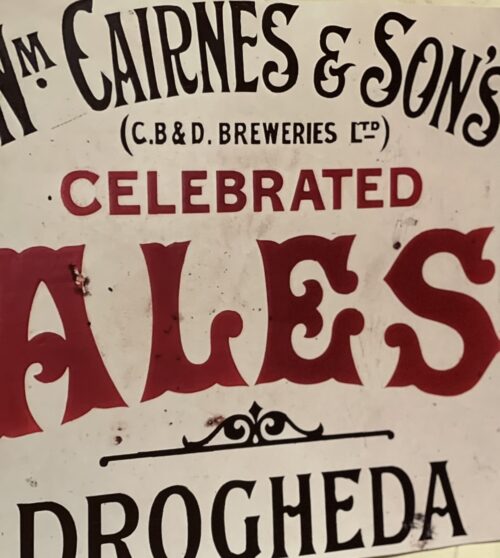
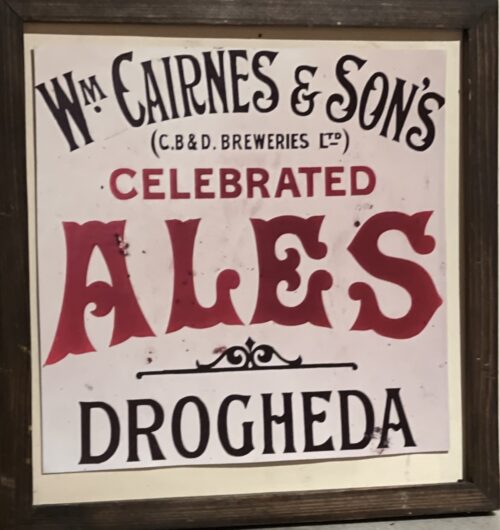 30cm x 30cm ANOTHER great industry on the Scotch Hall site was the brewing firm of Cairnes Ltd, one of the original firms of Irish brewers dating back to 1772 with the foundation of the Castlebellingham Brewery at the picturesque Co Louth village of that name.In 1825, William Cairnes, who was related by marriage to the owners of the ’Bellingham brewery, founded the brewery at Marsh Road, Drogheda, which, for over 150 years, gave employment to almost 200 workers and the firm was famous for its ales and stout. In 1889 the interests of the two breweries were pooled, a public company being formed under the title of the Castlebellingham and Drogheda Breweries Ltd. This title was changed for brevity in 1933 to Cairnes Ltd. For a good many years subsequent to the merger, the breweries were worked independently, each supplying its own customers throughout Ireland and abroad. However, in 1923, it was considered advisable to concentrate brewing in Drogheda, owing to the more advantageous position of the town, and the brewing plant and premises there, were more extensive. Actually the plant at Drogheda was one of the most up-to-date in Ireland and compared very favourably with that of breweries in England and Wales. The supply of brewing water was obtained from a 400ft deep artesian well on the company’s premises. (I wonder if it is still there) and this water was used with the choicest hops and malt made from the best Irish barley obtainable. The hops used came chiefly from Kent and when obtainable, a percentage came from the USA. The process through which the barley went from its arrival in the brewery until it emerged as ale or stout, was extremely interesting and quaint. The barley was first dried to a consistent level of moisture content and then stored for a few weeks before being steeped. It was then ‘floored’ on lots which the brewery had, as well as lofts in Dominic Street and Wellington Quay. These have, in recent years, been converted into shops and a high rise apartment block. Here on these lofts the growing process of the barley in the ground was artificially repeated, the growth however being terminated at the desired stage. The barley was then kilned and cured before being ground and mashed with hot water and the liquid was drawn off. It was then run to built-in coppers, where hops was added, then boiled, the wort, as it was called, being subsequently strained from the hops, cooled and fermented. The final stage was when the beer was casked (in wooden barrels) and matured.
30cm x 30cm ANOTHER great industry on the Scotch Hall site was the brewing firm of Cairnes Ltd, one of the original firms of Irish brewers dating back to 1772 with the foundation of the Castlebellingham Brewery at the picturesque Co Louth village of that name.In 1825, William Cairnes, who was related by marriage to the owners of the ’Bellingham brewery, founded the brewery at Marsh Road, Drogheda, which, for over 150 years, gave employment to almost 200 workers and the firm was famous for its ales and stout. In 1889 the interests of the two breweries were pooled, a public company being formed under the title of the Castlebellingham and Drogheda Breweries Ltd. This title was changed for brevity in 1933 to Cairnes Ltd. For a good many years subsequent to the merger, the breweries were worked independently, each supplying its own customers throughout Ireland and abroad. However, in 1923, it was considered advisable to concentrate brewing in Drogheda, owing to the more advantageous position of the town, and the brewing plant and premises there, were more extensive. Actually the plant at Drogheda was one of the most up-to-date in Ireland and compared very favourably with that of breweries in England and Wales. The supply of brewing water was obtained from a 400ft deep artesian well on the company’s premises. (I wonder if it is still there) and this water was used with the choicest hops and malt made from the best Irish barley obtainable. The hops used came chiefly from Kent and when obtainable, a percentage came from the USA. The process through which the barley went from its arrival in the brewery until it emerged as ale or stout, was extremely interesting and quaint. The barley was first dried to a consistent level of moisture content and then stored for a few weeks before being steeped. It was then ‘floored’ on lots which the brewery had, as well as lofts in Dominic Street and Wellington Quay. These have, in recent years, been converted into shops and a high rise apartment block. Here on these lofts the growing process of the barley in the ground was artificially repeated, the growth however being terminated at the desired stage. The barley was then kilned and cured before being ground and mashed with hot water and the liquid was drawn off. It was then run to built-in coppers, where hops was added, then boiled, the wort, as it was called, being subsequently strained from the hops, cooled and fermented. The final stage was when the beer was casked (in wooden barrels) and matured.

